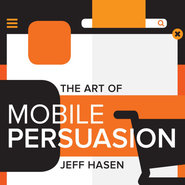By Jeff Hasen
If inattentive, impulsive, selfish, timid and illogical are words to describe ineffective mobile marketers, surely there are others to tag on courageous and successful professionals?
As a matter of fact, as I learned while researching and writing my new The Art of Mobile Persuasion book (artofmobilepersuasion.com), there are five words, beginning with pragmatic.
Everything and nothing has changed with mobile. We still need to sell stuff. It is just the how that is different.
The mobile marketing leaders focus squarely on business results rather than some squishy outcome that has little to no positive impact.
Other words that came from my year-long interviews with mobile and digital pioneers from Google, The Coca-Cola Company, REI, Expedia, among others:
Open-minded
Mobile is innovating so rapidly that it is unwise to lock in a long-term plan of products and services. The Coca-Cola Company is one of many companies that devotes “test” budget to new things such as augmented reality and wearables.
While the mobile mix varies country to country, what remains in place is Coke marketers staying true to the directive from Tom Daly, group director for global connections. Mr. Daly has mentioned 70 percent of time and money being spent on core wireless products and services that will move product off the shelf. Another 20 percent should go toward other mobile efforts that have more recently proved their worth. The final 10 percent are for what Mr. Daly calls “new things.”
“Seventy-twenty-ten isn’t in stone,” Mr. Daly told me. “It wasn’t established from the mountain. It’s a point of view that governs a way of prioritizing your activity, energy and resources. The idea is to spend more time on the things that you know work. You spend a smaller amount of your time, 20 percent, to make the things that you know work, work better. And then you spend 10 percent on new things. Is it a formula? No. It it a construct? Yes.”
Collaborative
Mobile efforts fail when they sit on an island. Strategists need to talk to creatives who need to acknowledge the importance of the media planner. The most successful mobile campaigns are fully integrated efforts, making existing marketing dollars work harder and be more measurable.
“On the agency side, it's connecting the data people with the agency folks,” Havas chief digital officer Sean Lyons said. “We're doing that more and more and making sure that we build teams that are integrating together and looking to solve these problems.”
Good-listener
"Mobile only” has a nice ring to it, but the reality is that few spend time on only one device. Over the course of a day, the typical user bounces from smartphone to computer to tablet, not necessarily in that order but with that mix of technology. Then you throw wearables in.
 Jeff Hasen
Jeff Hasen
Unless you absolutely know that your customer or prospect lives only on one, it is imperative for marketers to follow the customer journey through CRM, marketing automation, or a mixture that best fits their business.
“I better know that you, Jeff, visited Expedia this morning on your work desktop to search for a flight to San Francisco, so that when you pick up your phone on your lunch break to repeat the search, I can highlight the updates to the content you were looking for,” Expedia chief marketing officer David Doctorow told me. “You want the feel and look and quality of Expedia to persist, but the interface to follow the traits you expect on whatever device you’re interacting with.
“The result of our combined content, product and marketing strategy is increased engagement on the devices people are on because it’s an experience designed for the mode they’re in.”
Risk-taker
“Been there, done that” does not cut it in today’s marketing world. The courageous identify smart and measured risks to take, build consensus, go for it, learn and optimize. As many told me, some efforts will fall short. The business will not move forward if there is no effort to try something new.
“There are a lot of new bright shiny objects out there,” Jeff Klonowski, a mobile vet who is now director of digital retail for mobile and business development at REI, said to me. “We certainly take a viewpoint that in some cases, we want to be a leader. In other cases, we want to be a fast follower. It really just depends on the context of things.
“We're not a retailer that is going to chase every new idea out there. However, we evaluate a lot of those ideas and take a pretty hard look at them and say, ‘OK, does this make sense for our members and for the co-op? Does it fit to the types of offerings and features and functionality that our customer want.’”
Meeting customer desires and producing business successes brings to mind one other word – winner.
Jeff Hasen is founder/president of mobile consultancy Gotta Mobilize, Seattle. Reach him at [email protected]. His latest book is “The Art of Mobile Persuasion” (Frontier Press, June 2015).
{"ct":"lnB3DQK+Tj+LaO9JZaC2YAaVU7M8tOzl+RB9EUFgj1bmOGE3TUpSbWrOh0axlGD5XdlW4WHGtyC919NIvu3DVZ3FlVGC+DK2rdvK19Ki4bZungR6y+brE76IMbD6jRLQAAPCwmIFRwIfsZtgJD4wUJXKXE3AcPXCAFAS\/bzMLfCvAtfpMZhdno8A50fKSfhpz7Ks33CEm6jI9wh7o9PNqCEIpeapGqPtDSvU9ajSNQDRyzm7TWTLHuXZanrojxsbktwIPhQ99s879U\/pg9T1UQxAYI5rwXKGS5GdkYCZfio6bJtufZdXwjU3cuOEAbvISshWcGA8gp36UZP6Pn0E9pGmJbz1vEfe7wnH2xLBVED7cOG4Tu4e9XQzp1brZtHYWad3TW7v1q+x4pziMWrd4dPlc6oZyQqXbNqpkyscnbE9FlSQXn8KgCE2T4EtDSuLMofSybqM4hlK+NZwVU5I8i2O1upI6bfVnMDjtJaDrMmHmhx3r30VfimgETqCJlWrrX140iRX\/5efJFN67f6XJy3V0rfuBEGdfbZGsoafWYwgjZ2H5b0b7+dHfljFg0NJKpjyHnkGog0EtmalXoPWHMgruDZKporlSp9MqOB2OgjtB+SjHy9Uy0zYGfK4Bso8lPXplHHGZ9z\/oxo3Aps61BJ0cjlD0CS02OrlwNkwinPI2\/sGu52xMCXpPQjj0tsFZLW8pVlmGdV7DkIrv7uy7812hvL9ARVhhn5zTcHM07Yj3co6rmllwwBOHhreUFbcLG9sIpHQ\/p4PwjyNpzdZkNVD2YqgsJa8WBI8MT2\/r1tJJHkG8wMW6He8gFZrm\/jgpd581X1p+ZmFtzcUrBCen0CG11A0dH8HBpS2GvXfop7S7ljlYot2HZT1sQk6fFXc2D3LYH5\/P7NEHcY36yTIszL2kYQMMbtTIOy9t1H0o1vkU4I6mUT0LTXaeOsw913s2\/8dYHFjuiVJlrfYrSesSgmLqx+wWYIc\/DCMTDDpRBDNNXsywbveTfdhrWKqokP6HRC3LtiZ9idsXfUt05\/YyUbnTQ1Yk4C8tCJsjhFSMltM9ukmrY2NdFrp2Rbtb6yQojWoMnqhHK6CWHBzy9uRLShmBi6HJDftwwnF\/qvrQOsR8VSxs3Pit9UvdVhAh7KkLsqasOH\/+M2i85u50A0Chkcdnzm1DzVtAb1xOWmoS5BE4S5N92TPA6J8R3tXP1jjMOuWuZ0xgXwjIl5x\/VsrnFdDxg45RTTbbMDz\/w7klbFeQld7M2JeZj+ws5PX6Zfj9lAmr19AZCuSFub98yhkynMRmn7QWAU+EnUfhnYyNPpd7yPPkypqV96v6zDdjs6QO1cSs7pC9owzjILepGHunvvZMz6RUoQwBGk2yty3rC3oiZbCzaPYV8kjUV3huCkpKn6l5tQEQIhqX\/E2DS3ZWEdwTDiWuTGRIjISCCqLFgvQb5nJhWUpmZskzgWkdqZhD\/qbI8furYgFE05GEEFmsB+XB8mbBoSdkOo0qKjJlYWEvWOxPDa1qCUx6CNlIIZIHWOGG7K30XMTdKPRX0xjsYUlt8wW5xGkhldcHlaUeKKxU7w6znPNPA2Fn\/IVrAgt1lv2fqjP5zGWocFfjyQcxyQaMN\/V1Xuz1xsP4V7YoGb6f15VZO34HugdXBVkx7FBHcDWzE0i9mqXQ3FZgJ+zG6DQqyb4sAj7z3H\/0PUP8J0Hjq\/LnSCQ5xhNQXHWoX5Sw5\/J2Cx3iWBqpeNKTD6oTFZD+YnhtMfP4TlNCu\/8PXQZZYjrDdRIL8AHsvNciZivRhGIxYin5bJHvILSj69c1xGdKHXO9iYBnE85wpSfhY5Eb5OckHAAi83Ml3mV9i09Xst7MRMWKLdIgfpGSNaLN3U\/jaq9gKPYSP4UyiY3+x\/9JUOVdoBSGH4fT2KKKPEZC2z2RRNQ\/HDCZW9w5xiCq7tXPrXm5UV1hpZqinlRNkWVqtDXjL7xIKFfBGu77XWQ9KEhOIrDXE2XkEl42FMP8mIVJyxWA0ncBueSB1a2xglsH+PqsSJZLCJyFScA\/qz+Xnb6ZHAArpo2TZyOdvPCytEu570I+If0QJywlLyEr0DtX8XnvuDdPpbL3i5fko5kT7A2XN3thI0+1RQWUnvtmbfDHn97PDbgLOV5Pp5Uwtiu1lVPFltWIXFnWoZSeAJTXd4HvmLms8qUHLqFYGaVI9S6DRlIxSJn3V47U+yZ598SphZaBK5dF6DWqK0Wp6YBPSrjgwQWwPX4FOFeNFW5CUZ27Q1RoEXoSu3EsUhZDQL4NwvCkYjn5vBi27ohyLx81mDmwFYXXoVXchnl\/TBWqeMLYyIN\/ky4ZpIg8l\/MnZRLiy2hZ7jqigg8vKNfNEfkOy1ekZLNO9pYGMStQIo5DN1rZPu0EMcb+pVxL7ehIoe9sflncMTCRw6lf+StotBrvq8zBoVZwEbJxbf2cKhb\/ut9oCVcPIlv2iRjNSmhx9yRHRB50egeN9Am4is5JpNTHg3t1hOQTxmaciiPe+5lrH3srcEjR7v5OK1fpDj2EOTsSwAmBDkh\/7mhRA1skTQzUVI4\/6qSHr62lGakKdOe8vIftVudR0+rooVUWLzIe4nZ2MTmHfGAYvrUfVJsn1mYPixzy6M8n+Y\/Rlaz956aApx+eDQTDEaU2elXEDDL5pGVBpldUuUSq7p9Onn+yRe3zy0UPtcTI14Mhs9W7bdN15\/1qi+UyJmQncguGLbzFNoSHEonF4d2k0y0nTpVyn1PS9VWwicxIe68HOHHiMhIitoaYd8ICctyOlYcAq1jBXPdzRZ2A4BM7s01n4dycIsFYLS51bY1Wl4rj8tgl7hUqU24fks6g1da2qqxufassosKh8lK6qP801hbi5jJnCOiUeb3pMs9AndoznnTz5DEdFlnrCEKAA4ssi10Z7uMplN5qzv1fzAVu3lZwAKspI87MvimG2q\/r06zVFMobRVRvA2\/E6Ult4MmmmEXuimXWG9vEGQYtSEP97mX7bEWk9pUXOGPU0D3EXyTrVTinUzfjR6yp1hpllYjK86AT\/H1UA\/2uilMErZDg8P57MSbEKkV2lNIismGtyW6QL+cdnbGCmKjk+LP6168K3w2WQhUfmgFvVZB3S3MewUXyL6KWB9aH5H6VCajgouQD9u5SJuPC4to+n8d1H0U6QBUaHGSJIhlUjokGRLiBUJVh743vzR7ppzy52cDuOlYC2VtmOobpI3SYUNq\/7PfbegATI0GT726+5MwuIJO54ce1gfZoOYCei\/t\/8WhYuk4wi8tFWodmcQrrs1pcgyPPLEa9IT7GC78w\/EQfWLBfH5EPkVrh0bOtAiXst2bObcuMloGCszqN5u+2taBWnee2HQ1I+Y3p4yLxTQvfxtxeni9DLVbip1YhL3GTZ+PPHmq9fYPBetR7VoGjTG9Y\/0sDJBrJZWyTGp3z5rWfuaLRWdl0I+7uYpDl3IqJ90+38WUGReBm45ueBUMOL89PEdvnNborxQHYpIlRk\/SRCf6zpm0iHolmqnQ+\/OOr3\/yPaDhQq+Mq\/WarA0Mzp3oqXo4ZJU69Xa2RLFF1\/Beq2WagsuqWMr6HI6Tvb2bAfca9HWXIZkT04jkKxG1OlLU0ZLiwIsAzM9uRLwSocRRZn7x\/MFG4NvIdAnLsTCAwrhpnxmNf+u90veDiyzR5rXjTlVNkULBiwL6vJYkD6xckDkUnKeqG6x\/i2gnMfmw\/tnxrIIlPhIsVFqEpsmA9Z+7ZuEHllsKwXWGD+4pHCe7LTs0Ej9krZnN8mFcXRDQ1+vFD8o9cOuif1z6n3syJdI+qZiiFuPRS5NxXandgUQa3mNI1ZIw5RBJCJu6LsAWNpvbncqxxnOIpLvodJYfrQ64DqQ3AWrBofWj3DxZHZuphRL\/6F7VOYDew\/Bzd3HVheH+ABjxxIIluUH2ejLLtyqhhtGnosXUMsEMeSylx+7vDD8jFTYGk+4o02vMeGjcs9aP3nI6cIuNmnlyg1ZYcSJl0tcYf5DIwAupWFt6cJz9cX16BRN3JnGmB61FsDZXta\/ZPFYDq\/D6vv+eTJakDrFRdSpBPArfBR9bSSnLLC2Oy5IwIwejxk4Em+s2SPMzKJLTTCfRiXi2\/+l2XjW2vLaMnywQMtF\/lqDo02hZzFoHILjQ\/j2lyYMLHxBXcRrtCXJNToKqtoAx3j5OkJ3s89PvIbubNws5hMRhbWIesZ7YdEONbPBZkkwJJCstAPX+W6RRKZaO7Kbs3PDtmAA\/vYsteUkXSuUEzib+EGk0pUBF9gzCZJQZlYGYZ2mXQUnyt4VkSBk4x6lQLEr7A5cAO7C0WrHNrHsJtgzm3WN84WX9XKwaRqGn\/p2CX1vAfsS7EeFrY0sEeE26wpn5cmHmSMbtPQ84aDEighKwwcEspWkYxJuzucQ3QSKRT8g\/ZSUNxphpa5+hl5axfVRr6WMv7kry5XByjMMTFKGZhLffiJvuiEmLhwaXwzp3BctFIsqF4AWNcl9MNYrnHrpWQusb1I0Uqj7r1z\/B\/9k3z\/uUriTryS8+7oURDqd78y1vi2F46jSQDdk1IXN35vB\/Ywd5fSsrU+SWtIJEPA\/xFW\/\/m7pcFlJKhLPW3e90SG\/AA\/NqUubGanNRLgVpq22mR3XrE71yOdevi40sAXw68zcH1pF0VJ1TVmoPMmy4pWCkS1VYRs5X8KnvS\/U8loKikY4viqs7m3HVfs2OJTubA\/6uww0jNPISw4ahi9SElxRPgQqW6HzEWk+arvOf03\/TQkJEl9UgVPEpkCNPGtKSiAtAm5BoA\/gquXfZeloNW20N3iStx9UChSZ4MbrrsOPGYXu6ohIJm9\/M+IUHVGOMvg7ENXfX0vwUmhx3NLhVXCLmpCtznfs2tYyY\/2i0WhAzexYqu16BnlyOMvYRmmx07tnI9cooWCyUi1o89qOC6BiWv\/xttMZVzoBWr43UTNndAnK7cZrMDqOj0eLlalQ+woJAkuDNfI6baRu8x77QOoM6DAMCRj8IjZSl+CU9zjzGYGX8jZE5L5ka4Ql+LJEwH2hzGnXi1aQljZpV77DqLorNgrbKEh+oyBZ1JyX7YUZ6EIZYw71ZjBCB7k97hNJYdS4h\/Xf5izF9Ek+oPqrzP0JYLbrV3P0wLcGUT3TIH2Xzt5GEuc7c279hW9w\/JUN\/OQLmzV\/45JTYslEg8FQ5aUy7unaPM3SHxJFTbrBeyzKWG+UeEUhAgevDUvn1po76mAXWtXSaqjQvMrlcpKYoKsEFn3FENblRkF1l7zWdz6wHgDIocFHQvzXEqhmgpOBDGPqQ+hppRjQBKp8mcCN4Wlr8UVfNyZubflkqXA8fvKzJCeeeB36+GnAfbK1wI3qXBqSXwvw8Yu7Yc2xd2qA+QmMEiWheKbuqRofzkKdLxr7CLaCM\/PrDRjaNFc1f88qbFKqZprgAaiFNm1u53Hw6oS3mFExSMO2+3AAbZWAvUYbukIwSyAmUpFVeOhZuTNMXYWcwLzcH222Qgk\/9B2QbvvTpWxaGRiNOlCIY+aQVI3gZ2ZtaeBgvTZvBlZ\/Dy0vCpOR1H8nG99Wwi951KVnFXbEGyV50ISo3IwT1TjEvT\/6LcT1OPxnp3lg0n1ckrBNGwTegWQek5gECZxfTwfXrQQOVcBAGdjyq6WZ9RgnrVSaErCXK3wKI0+biK+DehgesiLZFvekGQZUcCRMoqAZbom63Wd9kEKn0YshWdBJrCEKKISa3ZomOiMcH4g7gpWR8g2NtoxZvBcJDT6z21WEohzHHQIdk70k+K02ezbVC1CVdHUww3SZkyjqaBV8ybXYHn\/PIgb9EuxNJSTgZB1MBw2+i+gGIcrpipJHKkyxh6ToR0e+olaN4NLYYKau2dIntvX37s9jQZAOThfkJhjct4cy5M+kO8UTCHAycSmQC643SkbNWqOfe3t7gcaYTtLHWM\/yalwT3sXPQeiJP\/pB1vtANu1bFMWlSotz3IR1\/wd7zVGrAHhOqkqX9IMp\/IYsl8qfxw7RcPKLSvnUhH3JfzIoa2dtN97wgOabj8WKnxFDFVKmIWKc8EL5IG\/kDeE2+g+O16tMX5QLPtQV79xJiCP0ZpdQTuzPHjmy43iARV24mgjSPDoLRiqqvoyb2FiGTNDpFlbpU9wJ7j0FfkgQzd4sWuNUrf3YrVJvsvyikVHRjQ\/kLYZc47AObAXhzO0TBgYnOwikFO4zWxAmtKzv4LpJOa8fWs9p98mvY7Li3mH5kUdbVyur7VoOzQr7jCidFdh3dsIn1beRHhXH1MZWEWapDFkQjVDv4HpDGd8t+w5NMlwLt6urubfG4nCNiFe7iBrHsqS02N\/qcwsBCh2IOvG1aqXIg3jLPudOUylAYStIAa5LAoXE4dDgfsQEvxHwIfCatB1fY5CKbfbJuDEFD8OTr0p2KLQ3W1aNh+4+NeA5Jg5q9QiXPGTZJCySP4reaI60snDPyNAyvoCKaoAcAgLwjxYVnuo2gxg3fdhp9vjSVoCf7L8dFxPQNHq8WPBRwpgIZpVcEz6Nexu7Xy8+LXCCGRCXWWpxrXuZPEu3lWxXzgK8oXFkzfYRrgA8otOFs6zYF9CvO56gtQ8+jHtYMdJSSR\/3iswGpnTTUecm4SDqPLFSlzaDOEh2NfcGTBo2lN8bhdS\/4GpBbVyNmJQkfgUvHkkn7Xfk2McGsPwWhFeIib3k2bqR3Jimkf5iFnuwNi52haQM0uauuDWB8J61shGtl7gTa0FN6t9Dba70skKJxRIYRDSWbxAhu9qCJYWTtk9UGwCaBK1KGiz46aLT08dxKL5S3\/3iPCjJQLyj5SkoBqKMJUgiT46Fa9UTmMCzw6T48\/vGJB3nBej8YNX9qj0MvHmx2BJM8NavOYcs5rKrEsutMQ2VdKtmcpzk4ZfHLQpPzWoSYP\/G45oT2Vzja3hnmhOQG1w4QkuaQx20cFUXTG9cY\/+haNs1SXWNKu+LwayU8ExxbkN1MSG5szwyBwl+Dpx7QVdXWxkpkeu\/SZGrKk0dQnTVcGfr7MZBtIprlVueDh7qegsmU\/ZSCNt3oItOfbqh2eKRv0SsydclmnG6XxyIoZUucShT9+GszEyo\/c4wgKnTyZomN8bi+IAVALtcQFHccy\/9bDrUoQkf39JLWZwDQZJ+eSkJ+zAlG1w8jYco3LMCeOvvQFvV2e7JhIWLQi9Pa7nDckTx81LVc\/UF3eRbWPZ2j0LMS5PILJogdMGJ8ooQRlGini03cf1ezxuvl1uVx5o4KL\/5BN5uErIs3D5M7a87uLwBNvQOgnJGOhsqDwlo12gapAcfqpBG4YtFiqGyTczlAqZbKE6bJrC20u9VMx9AqHz57+JC9Ma4zUtStHfDLkEkTyuQO4LP3V9X1vZWzwN8wc5g1fjepsPCeECLy0eoe7d4kU0lVbYtmr5eWDYcv6SepMre\/jZIrmQP1jIOE6cQsQPcEdfPGuatqC154TK0pHdrqI85Gtq9h\/kCvbCFvIKcqiBCErT3d0y6rL5Cw8yMbRL6ohaspX56iW7dCNREWA8E5qXZWceO\/C0ObnEx9Eq2dVVQ2WpLUVDm6kyf2YWrlrNyffUc114C3DJLs0YAS7GfvvxKyDcPjztV9JMDsEdJmM5r0vNpn8YjqPNGcM+zSixHT8OVVG0LoMKzhPedR05p22Xg0pzR6QmzXgWgRWLZVE1IqiXpvb1NNyC64qgZ4XvK66eVJsG+YN0k8y+W34OYnjEBgoALcwf3An3Za6sSgdtBKhkqJyHQFJS0EQC6SKHZFqpc3QZrF9gRiIGgX6Xk0OkLPYW\/+RZcU7Nu9EV+ca+gnHi4o64+ybo7n\/0rDUe6QiUPwHk7U2D2swuGCSTftGfMgVdkhcEKudRG4Go7iI6hEpQqVy4cRw6LwDAo1Kh08oAU\/FqYqucQ5yL\/2\/Bw+bzn2w1p5rBCsEtFN43Bf0l3J0GyoTv5uSc\/N3IL1cueSY8mQXGdzkTtaVLAcA38hO96OxxN\/8arJS6IGddLbS2F0i1nGt57zFxcb1XayF6MDmmCqi\/M6+bZCbijGB66jhaLUPPRCViZqVEDm+aYqzmaaBDO46TF6EIEMPP1wkoVzjOJmHxYHL58NblLGDENrqCVd3VXrFXPeC+\/YdUNpF5Q4n1XNa9eUxGdhqpBviAU+Ikfz1YS7E6XEfwIP6llHv7LLRHeD3es\/KK5tTTUuLXfVgzhI0WQojqIwSJF9dMu5AImMNJC3jzL5XB7JrBKzw1Gvn++AvcX\/aEK6dt0DX\/u5z9bnA8D+sQgVtwiYhAB65CdwC5iGybE1\/ohDT3YpicWM9m\/Q3uxPOayr+1yB218+zsddqjct8yM6UTgpxJ3Od27aSGXytIxq8n7xZhnnZhc2gsMU6eWXodYLcJeKfSQ3m\/afK2aQta\/99QdwbLnx90vz7R4q3GG1Dvfld5x9+1fNdurqJRs6yXgx0jex3Z665LQCsXD\/ippo0pXWQe8UUDY95Ya7gxgXFHaGSJ0EpNrBxTW0R0ni3D3Dw9oRM557NrC649Gct6xYTtYphXr10NyGnbdw3+c4Rt6xRkl7Z3P7za8VVhhguM4Bh9Uzd7wzpwYWckXl","iv":"0a4f4178a81dfc16c35927a7874c0041","s":"f71e44b7fab9a5ac"}

 The Art of Mobile Persuasion, by Jeff Hasen (Frontier Press, June 2015)
The Art of Mobile Persuasion, by Jeff Hasen (Frontier Press, June 2015)